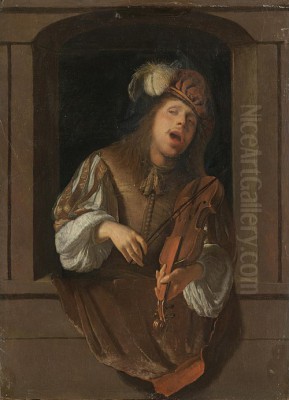
Jacob Ochtervelt stands as a significant, albeit sometimes overlooked, figure within the rich tapestry of Dutch Golden Age painting. Active during the 17th century, a period of extraordinary artistic flourishing in the Netherlands, Ochtervelt carved a distinct niche for himself, specializing in elegant interior scenes, refined genre paintings, and insightful family portraits. Born in the bustling port city of Rotterdam in 1634, he spent his productive years between his native city and the vibrant metropolis of Amsterdam, where he passed away in 1682. His work offers a captivating window into the domestic lives, social customs, and aesthetic preferences of the Dutch elite during this prosperous era.
Ochtervelt's paintings are particularly celebrated for their sophisticated depiction of textures, especially the luxurious sheen of silk and satin fabrics, a skill that lent an air of palpable richness and refinement to his compositions. He captured the quiet elegance of well-to-do households, focusing on moments of intimate interaction, leisure, and the subtle dramas of everyday life among the Dutch upper-middle class and aristocracy. While perhaps not achieving the widespread contemporary fame of giants like Rembrandt van Rijn or Johannes Vermeer during his lifetime, Ochtervelt's unique contributions, technical finesse, and sensitive portrayal of his subjects have earned him a respected place in the annals of art history.
Early Life and Artistic Formation
Jacob Ochtervelt entered the world in Rotterdam in 1634. His father, Lucas Hendricksz. Ochtervelt, held the position of a bridge keeper, placing the family within the working fabric of the thriving city. While details of his earliest training remain somewhat scarce, it is well-documented that he became a pupil of the prominent Haarlem painter Nicolaes Pietersz. Berchem, likely around the late 1640s or early 1650s. Berchem was a highly successful and versatile artist, known primarily for his Italianate landscapes but also proficient in other genres. This apprenticeship would have provided Ochtervelt with a solid foundation in drawing, composition, and painting techniques.
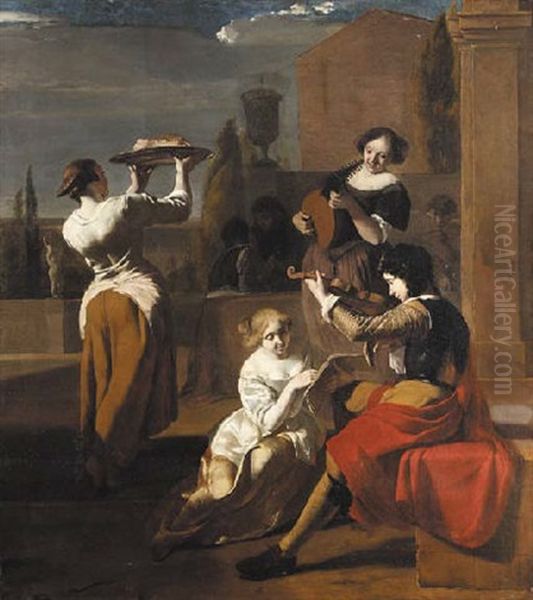
Further shaping his artistic development was his time spent, possibly concurrently or subsequently, under the tutelage of Ludolf de Jongh in Rotterdam. De Jongh, himself a former pupil of notable artists like Cornelis Saftleven and Anthonie Palamedesz., was known for his genre scenes, portraits, and landscapes. It is believed that Ochtervelt, along with the celebrated painter Pieter de Hooch, may have studied with De Jongh around the same period. Some sources also suggest a possible connection or period of study with Frans van Mieris the Elder, a leading figure of the Leiden 'fijnschilders' (fine painters), known for their meticulous detail and polished finish, though this link is less definitively established. These formative experiences exposed Ochtervelt to various prevailing styles and subject matters, laying the groundwork for his own distinct artistic voice.
Artistic Style and Techniques
Jacob Ochtervelt developed a style characterized by elegance, refinement, and a keen observation of domestic life. His primary focus was the interior genre scene, often populated by members of the affluent merchant class or aristocracy. A hallmark of his technique is the masterful rendering of textures. He possessed an exceptional ability to capture the distinct qualities of different materials, particularly the lustrous sheen of silk, the soft richness of velvet, and the crispness of linen. This tactile quality adds a layer of luxury and realism to his depictions of fashionable attire and opulent furnishings.
Light plays a crucial, often subtle, role in Ochtervelt's work. Unlike the dramatic chiaroscuro favoured by Rembrandt or the luminous clarity of Vermeer, Ochtervelt often employed a cooler, more diffused light, frequently silvery in tone. He skillfully used light to model forms, create atmosphere, and draw the viewer's eye to key elements within the composition. His handling of light contributes significantly to the overall sense of calm and sophisticated restraint that pervades many of his paintings.
Compositionally, Ochtervelt frequently employed motifs favoured by his contemporaries, particularly Pieter de Hooch. He often structured his scenes using doorways or windows that open onto adjacent rooms, corridors, or exterior views. This device, known as a 'doorkijkje' (see-through view), adds spatial depth and complexity to the scene, hinting at a world beyond the immediate focus and enhancing the sense of domestic space. His figures are typically arranged gracefully, engaged in quiet activities such as making music, reading letters, receiving visitors, or attending to children, conveying a sense of decorum and ordered living. While admired for his elegance, some later critics noted that his perspective occasionally lacked the rigorous mathematical precision seen in works by artists like De Hooch or Samuel van Hoogstraten.
Career Trajectory: Rotterdam and Amsterdam
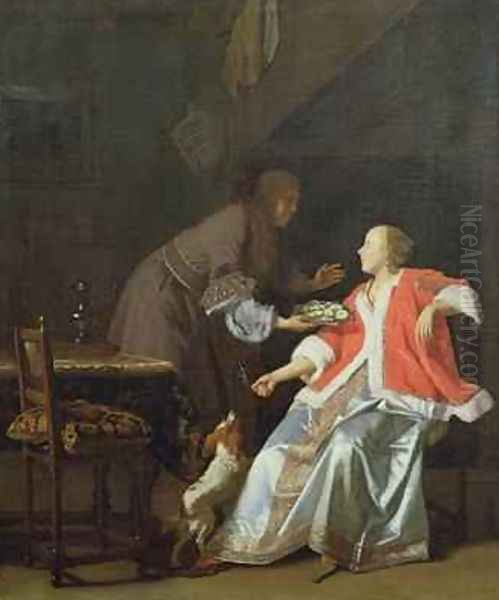
Ochtervelt's professional life unfolded across two major Dutch cities. He appears to have begun his independent career in his native Rotterdam. In 1655, a significant year personally and professionally, he married Dirkje Meesters. This union likely coincided with or shortly preceded his decision to relocate to Amsterdam, the bustling economic and cultural heart of the Dutch Republic. Amsterdam offered greater opportunities for patronage and exposure within its thriving art market.
He remained based in Amsterdam for the remainder of his life, a period spanning roughly twenty-seven years until his death in 1682. While the exact division of his working years between the two cities is debated (some earlier accounts suggested a longer period in Amsterdam, which seems unlikely given his lifespan), it is clear that Amsterdam became his primary center of activity. His move reflects a common pattern among ambitious Dutch artists seeking broader recognition and clientele.
Despite the sophisticated circles he depicted, Ochtervelt's own financial situation appears to have been somewhat precarious at times. Records indicate periods of economic difficulty. A notable commission came in 1674 when he was tasked, along with his brother-in-law, with painting the portraits of the Regents of the Amsterdam Leper House (Leprozenhuis). This type of group portrait was a prestigious undertaking, suggesting a degree of established reputation. However, other documents reveal financial struggles, including a dispute over debt with a colleague named Lodewijk van Ludick, which ultimately led to Ochtervelt having to relocate his residence from the prestigious Keizersgracht to a more modest dwelling near the Spiegelstraat. This contrast between the affluent world he painted and his own economic realities adds a poignant layer to his biography.
Themes and Subject Matter: Chronicling Domesticity
Ochtervelt's oeuvre primarily revolves around the depiction of Dutch domestic life, particularly within upper-middle-class and aristocratic settings. He excelled at capturing the nuances of social interaction and the quiet rhythms of the household. Music-making is a recurring theme, with elegantly dressed figures gathered around virginals, lutes, or cellos. These scenes, such as A Musical Company, reflect the importance of music as both a leisure activity and a symbol of harmonious living and education among the Dutch elite.
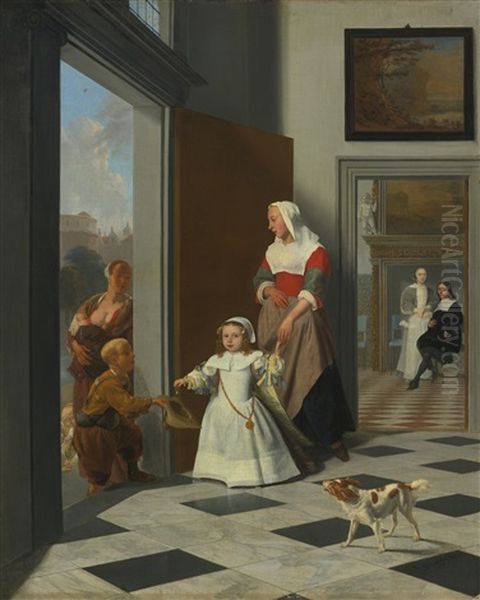
Another signature theme for Ochtervelt is the interaction occurring at the threshold – the doorway connecting the private interior with the public exterior. He painted numerous scenes featuring street vendors, such as fishmongers, grape sellers, or cherry peddlers, offering their wares to the lady of the house or her servants. Works like A Fishmonger at the Door (1663) or The Grape Seller (1669) exemplify this motif. These paintings explore the boundary between domestic sanctuary and the outside world, highlighting aspects of daily commerce and household management. The doorway acts as a framing device, often silhouetting the vendor against the brighter light of the street while illuminating the refined interior.
Family life and portraiture also form a significant part of his work. While sometimes creating formal group portraits, Ochtervelt often integrated portraiture into genre settings, as seen in A Family Group. These works depict parents and children in their comfortable home environments, surrounded by objects that signify their status and prosperity. He captured moments of parental affection, children's play, and the overall atmosphere of familial bonds, contributing significantly to the development of the family portrait as a distinct genre in Dutch art. Other common subjects include ladies receiving visitors, reading or writing letters (a popular theme reflecting literacy and communication), and scenes involving nurses and children, such as the highly valued A Nurse and a Child in an Elegant Foyer.
Analysis of Key Works
Several paintings stand out as representative of Ochtervelt's skill and thematic concerns. The Oyster Meal (c. 1664-66) is perhaps his most famous work, not only for its artistic merit but also for its dramatic modern history. The painting depicts an intimate scene with a man offering oysters, considered an aphrodisiac, to a woman in a richly appointed interior. The rendering of the figures' clothing, particularly the woman's shimmering satin dress, is exquisite. The work was looted by the Nazis during World War II from the Smidt van Gelder family collection. After a complex journey, it was finally restituted to the heirs 73 years later and subsequently sold at Sotheby's London in 2018 for a significant sum (£1.9 million), an event hailed as a "miracle" of art recovery.
A Nurse and a Child in an Elegant Foyer (c. 1663) showcases Ochtervelt's ability to create scenes of quiet domesticity imbued with elegance. Set in a grand entrance hall, typical of affluent Amsterdam homes, the painting features a nurse presenting a young child, possibly to a visitor just outside the frame or simply engaging in a moment of care. The architectural details, the tiled floor, and the glimpse into another room demonstrate his skill in rendering space. This work achieved a remarkable price ($4.4 million) at a Sotheby's New York auction in 2014, reflecting the high regard in which Ochtervelt's work is held today.
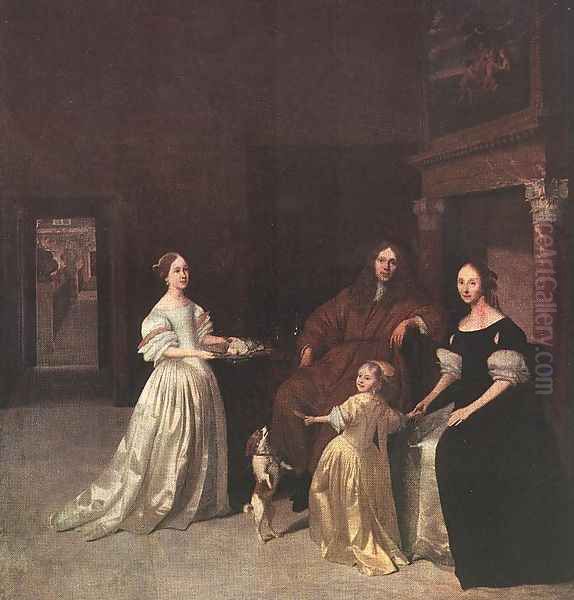
A Fishmonger at the Door (1663), housed in the Mauritshuis in The Hague, is a prime example of his threshold motif. The composition contrasts the dimly lit, refined interior space, where a lady inspects the fish, with the brightly lit exterior glimpsed through the open door where the fishmonger stands. The painting captures a routine transaction but elevates it through careful composition and attention to detail, from the scales on the fish to the textures of the fabrics and the tiled floor. Similar qualities are found in The Grape Seller (1669, Hermitage Museum) and A Cherry Peddler (c. 1668-69, Museum Mayer van den Bergh, Antwerp).
A Musical Company (c. 1670, Cleveland Museum of Art) represents his frequent depictions of musical gatherings. It shows a group of well-dressed individuals engaged in making music together in a comfortable interior. Such scenes were popular, reflecting social harmony and cultural refinement. Ochtervelt captures the concentration of the musicians and the relaxed atmosphere of the social occasion, paying close attention to the details of the instruments and the fashionable attire. His ability to render the interplay between figures in a shared activity is evident here.
Ochtervelt and His Contemporaries
Jacob Ochtervelt worked during a period teeming with artistic talent in the Netherlands. His relationship with Pieter de Hooch is particularly noteworthy. They likely trained together under Ludolf de Jongh and possibly shared Nicolaes Berchem's studio for a time. Both artists specialized in interior genre scenes, often employing similar compositional devices like the 'doorkijkje'. However, their styles differ in subtle ways: De Hooch is often noted for his warmer light and more rigorous perspective, while Ochtervelt favoured cooler tones and excelled in rendering the luxurious textures of fabrics.
While associated with De Hooch, some art historians argue that Ochtervelt's artistic sensibility aligns more closely with painters like Gerard ter Borch and Gabriel Metsu. Like Ter Borch, Ochtervelt demonstrated a remarkable talent for depicting silks and satins and often focused on quiet, elegant interactions between figures. Metsu shared Ochtervelt's interest in narrative detail and the depiction of everyday activities within refined settings.
Compared to Johannes Vermeer, the Delft master renowned for his transcendent use of light and enigmatic scenes, Ochtervelt's work appears more grounded in observable social reality, though sharing a focus on tranquil interior spaces. His genre scenes lack the boisterous energy often found in the works of Jan Steen, leaning instead towards decorum and restraint. While influenced by the Leiden 'fijnschilders' like Gerard Dou and his possible teacher Frans van Mieris the Elder in terms of detail and finish, Ochtervelt generally worked on a slightly larger scale and with a somewhat broader touch.
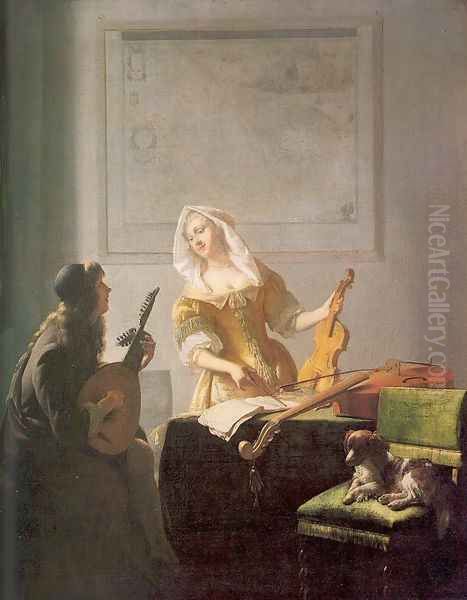
His career in Amsterdam placed him in the same city as the towering figure of Rembrandt van Rijn, although their artistic concerns were vastly different, with Rembrandt focusing more on history painting, portraiture, and dramatic psychological depth. Ochtervelt's focus on genre places him alongside other specialists like Nicolaes Maes (in his later career) and Emanuel de Witte (known for church interiors). Understanding Ochtervelt requires situating him within this vibrant network of artists, acknowledging both shared conventions and his unique contributions, distinct from landscape specialists like Jacob van Ruisdael or still life masters like Pieter Claesz and Willem Claesz. Heda, or the great Haarlem portraitist Frans Hals.
Reception, Legacy, and Rediscovery
During his own lifetime, Jacob Ochtervelt did not achieve the level of fame or critical acclaim accorded to some of his contemporaries. While he secured patronage, including the significant Leper House commission and a close relationship with collectors like Hartlief van Cattenburgh who owned several of his works, his name was not widely circulated in contemporary art literature. The influential art theorist and biographer Arnold Houbraken, writing in the early 18th century, mentions Ochtervelt only briefly. This relative obscurity might be partly due to his work being held in private collections or perhaps being overshadowed by artists with more extensive workshops or broader thematic ranges.
For a considerable period after his death, Ochtervelt remained a relatively minor figure in art historical narratives. However, beginning in the late 19th and particularly during the 20th century, a reassessment of Dutch Golden Age painting led to a renewed appreciation of his work. Art historians began to recognize his specific talents: his exceptional skill in rendering textiles, his sensitive portrayal of domestic interactions, his characteristic use of the doorway motif, and his contribution to the genre of elegant interior scenes and family portraiture.
Today, Ochtervelt is recognized as a significant master of the Dutch Golden Age. He is seen as a pioneer in developing certain types of genre scenes, particularly those involving interactions at the threshold and intimate family groupings within genre settings. His work provides invaluable visual documentation of the material culture, social customs, and aesthetic values of the Dutch elite in the 17th century.
His modern legacy has also been shaped by the provenance history of some of his key works. The restitution cases involving paintings like The Oyster Meal and The Lemon Slice (Das Zitronenschenibchen), returned to the heirs of Jewish collectors persecuted by the Nazis, have brought his name to wider public attention in recent years. These events underscore the enduring value and complex histories attached to Old Master paintings.
Museum Collections and Market Value
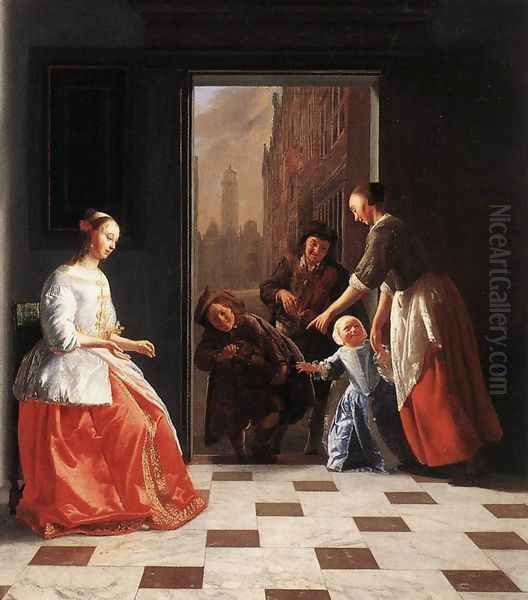
Works by Jacob Ochtervelt are now held in the collections of major museums across the world, testament to his recognized importance. Notable holdings can be found at the Rijksmuseum in Amsterdam, the Mauritshuis in The Hague, the Museum Boijmans Van Beuningen in Rotterdam, the National Gallery in London, the State Hermitage Museum in St. Petersburg, the Cleveland Museum of Art, the Metropolitan Museum of Art in New York, the Art Institute of Chicago, and the Manchester Art Gallery, among others.
His presence in these prestigious institutions allows audiences worldwide to appreciate his artistry. Furthermore, the prices achieved for his paintings at auction, such as the multi-million dollar sale of A Nurse and a Child in an Elegant Foyer and the significant sum realized for The Oyster Meal even after restitution, demonstrate his strong standing in the current art market. This market recognition reflects the art historical reassessment that has elevated Ochtervelt from relative obscurity to a respected master of his era.
Conclusion: An Elegant Chronicler of an Age
Jacob Ochtervelt occupies a distinct and important place within the constellation of Dutch Golden Age painters. As a master of the elegant interior and the nuanced genre scene, he captured the refined atmosphere and material comforts of the Dutch elite with remarkable skill and sensitivity. His exceptional ability to render the textures of luxurious fabrics, his sophisticated use of light and composition, particularly the recurring doorway motif, and his focus on the quiet interactions of domestic life define his unique artistic contribution.
Though perhaps less celebrated in his own time than some peers, subsequent generations have come to appreciate the subtle beauty and historical significance of his work. He stands as a key figure in the development of family portraiture within a genre context and as an insightful chronicler of the social fabric of Rotterdam and Amsterdam during the 17th century. From intimate musical gatherings to everyday transactions at the doorstep, Ochtervelt's paintings offer enduring glimpses into a world of quiet prosperity and ordered elegance, securing his legacy as a significant artist of the Dutch Golden Age.